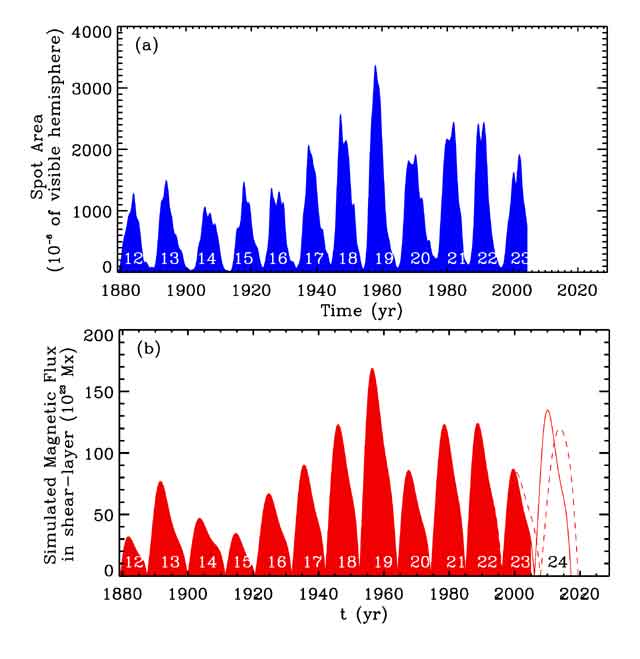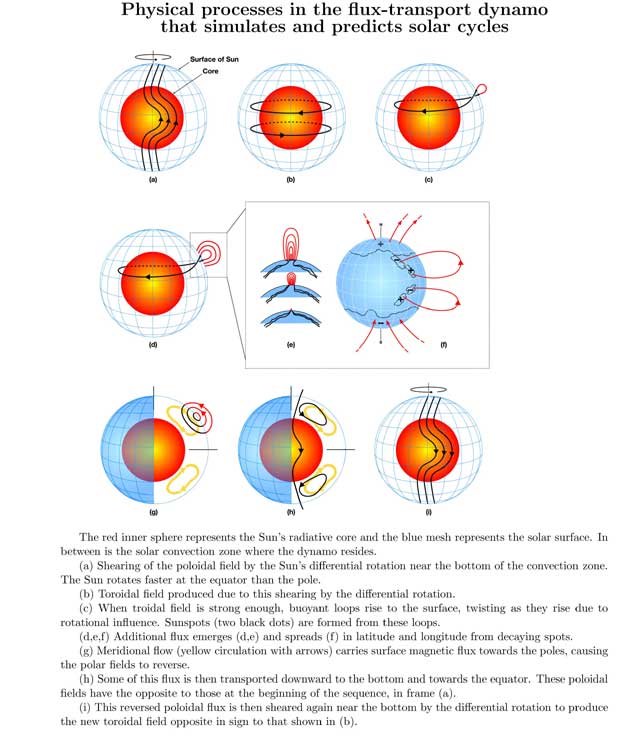Výzkum v poslední době předpovídá bezprostředně hrozící příchod většího množství intenzivních slunečních bouří z 50-tých let.
Autor: Doktor Tony Phillips, [NASA ] U.S… Via Dino Bloise, U.S…
Tyto zprávy jsou již potvrzené: slunečné minimum přišlo. Sluneční skvrny zmizely. Nejsou tam žádné slunečné erupce. Slunce je klidné. Věští to klid před bouří. Skupina badatelů oznámila, že bouře je na cestě – nejintenzivnější během slunečného minima jako v padesátých letech.
Předpověď byla udělána řízením od Mausumi Dikpatiho z národnostního centra atmosférických výzkumů (národní centrum atmosférický výzkumů – NCAR). “ Následující sluneční cyklus bude o 30 až 50% intenzivnější než předešlý. Jestli je předpověď správná, vzplanutí sluneční aktivity v dalších letech, které se přihodí bude stěží menší než byly jedny z historických slunečních maxim roku 1958. To bylo velké maximum.
Epocha vesmíru začala jakmile: satelit sputnik byl vyslán v říjnu 1957 a Průzkumník 1 (první americká družice, Explorer 1) v lednu 1958. V těch letech nebylo možné, aby bylo známo jestli sluneční bouře se přiblíží k hranici síly signálu celulárního telefonu. Lidé se dozvěděli, že se stalo něco ohromného, protože světla severu byla viděna již třikrát v Mexiku.
V současnosti, maximum hodně podobné síly by mělo významně ovlivnit mobilní telefony, přístroje GPS, klimatologické satelity a na mnoho dalších moderních technologií. Předpověď Dikpatiho je bez precedentu. Téměř dvě století od doby objevení 11-ti letého slunečního cyklu vědci bojovali o předpověď intenzity maxima budoucnosti, a selhali. Největší část může být intenzivní jako jedna z roku 1958, nebo stěží zjistitelná jako v roce 1805, není to podřízeno žádné zákonitosti.

Klíč k rozluštění záhady, jak Dikpati vysvětluje se vyskytl o několik let dříve. Je to dopravníkový pás slunce. My máme něco stejného zde na Zemi: velký dopravníkový pás oceánu byl zpopularizován filmem „Den poté“. Tento systém čerpá vodu a teplo oceánu. Tak jako ve filmu, se dopravníkový pás slunce zastaví a to způsobuje chaos v pozemském podnebí. Dopravníkový pás slunce je, nikoli z vody, ale z plynu jež vede elektřinu. Ten natéká dovnitř vinutím, které jde ze slunečního rovníku k točnám a vrací se. A tak jak velký dopravníkový pás oceánu ovládá na Zemi podnebí, slunečný pás ovládá podnebí naší hvězdy. Konkrétně, ovládá cyklus slunečních skvrn. Odborník na slunce David Hathaway fyzik z národního středu technologie a přírodních věd prostoru (národní prostor věda & technologie střed – NSSTC) to vysvětluje takto: první co zmíní je otázka „ co to vlastně jsou sluneční skvrny?“ – jsou to pouhé produkty z magnetismu, vytvořené vnitřním dynamem slunce.
Typická sluneční skvrna trvá několik dní, stěží týden. Brzo slábne a rozloží se a zůstanou po ní “ slabá magnetická pole „. Toto je pásový dopravník. “ Vyšší část dopravníkového pásu vyjasní povrch slunce, odstraní magnetická pole pozůstalých slunečních skvrn. „Pozůstatky (po skvrnách) táhnuté“ směrem k točnám a k hloubce 200,000 kilometrů, kde je magnetické dynamo slunce může zesílit. Pak pozůstatky (zmagnetizované) začnou znovu působit (zesílené), oni se nabijí a odplují plné života k povrchu „. Prostě, (stručně řečeno), nové sluneční skvrny! Toto všechno se stane velmi pomalu. „Potřebují skoro 40 let k tomu , aby pás dokončil rotaci“, říká Hathaway. Rychlost se mění „z pomalého 50-ti letého rytmu k rychlému 30-ti letému“. Když se pás “ zrychlí „, znamená to, že mnoho magnetických polí po pozůstatcích je odstraňováno, a že budoucí sluneční cyklus bude intenzivnější.

Toto je základ slunečních klimatologických předpovědí: “ pás byl zrychlen v cyklu 1986 až 1996″, říká Hathaway, “ magnetická pole ze kterých tehdy zbyli pozůstatky, se znovu budou objevovat nyní jako velké sluneční skvrny v periodě 2010 až 2021″. Jako většina expertů v jeho oboru, má Hathaway důvěru v teorii dopravníkového pásu a shoduje se s Dikpatim podle kterého následující sluneční maximum bude velmi intenzivní.
Ale neshodnou se v jednom bodu. Předpověď Dikpatiho lokalizuje maximum v roce 2012. Hathaway si myslí, že to přijde dříve, snad v roce 2010 nebo 2011. „Historie ukazuje že cykly velkých slunečních skvrn zesílí rychleji než cykly malých skvrn“, říká. „Doufám , že uvidím první skvrny dalšího cyklu na konci roku 2006 nebo 2007, a maximum přijde kolem roku 2010 nebo 2011“. Kdo z nich má pravdu?
Jedině čas nám to řekne. Ale v každém případě, bouře se přibližuje.
Od: Dr. Tony Phillips.
http://ciencia.nasa.gov/headlines/y2006/10mar_stormwarning.htm?list304408
Upozorňuji, že jde o volný překlad a tak omluvte případné nedostatky v překladu.
Vlado
